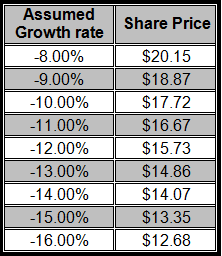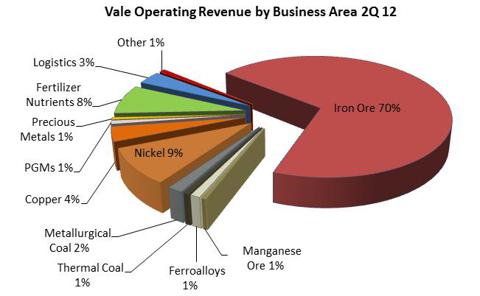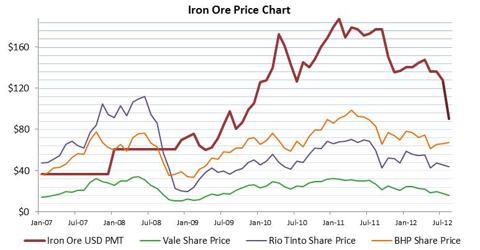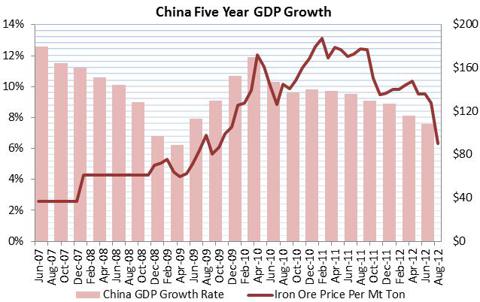Source: Seeking Alpha
August 30th, 2012
I last wrote on Vale (VALE) in early July this year, and since then, the company's price has fallen further by 22%, and is now trading at around $16 per share. This rapid price decline has seen a number of market pundits emerge, declaring that with a price-to-earnings ratio of around six and a dividend yield of 7%, the company is now a stunning value investment opportunity. In my previous article, I came
to the conclusion that Vale was a particularly volatile stock with an
unpredictable future because of the significant uncertainty surrounding
the company and its operations. This includes the ongoing uncertainty
surrounding iron ore prices and the direction of the Chinese economy, along with the growing political risk. At this time, none of these risks have subsided, and in some cases have only magnified, increasing the difficulty in predicting the direction of the stock.
Financial performance continues to be poor
While the company's second quarter 2012 revenue
increased in comparison to the first quarter (QoQ) by 7% to $12
billion, net income fell by 30% to $2.7 billion. The company's EBITDA,
which I believe is a better measure for comparing financial performance,
increased QoQ by 3% to $5.1 billion.
But in comparison to the
same period for 2011 (YoY), Vale's second quarter 2012 performance was
extremely poor. Reported revenue was down by 21%, EBITDA was down by 44%
and net income declined by 58%. It is this considerable downturn in financial performance that has caused the share price to plunge 40% over the last year.
The
company's cost-of-goods-sold (COGS) for the second quarter 2012 also
increased QoQ by 5.7% to $6 billion as a result of increased production.
This gives Vale a COGS to revenue ratio of almost 50%, which is an
indicator of efficiency, remains unchanged from the previous quarter. This indicates that, despite increasing production, Vale has been able to continue operating efficiently -- and more efficiently than either Rio Tinto (RIO) or BHP Billiton (BHP), with COGS to revenue ratios for the second quarter 2012 of 67% and 69%, respectively.
These numbers, along with the many positive comments coming from the Vale camp regarding the future of iron ore prices and company performance, leave
a particularly positive view of the company. But there are many
additional factors that investors need to take into account before
taking the plunge and investing in Vale at this time.
Despite attempts to diversify production, iron ore is the key profit driver
The majority of Vale's revenues are derived from iron ore products, which in the second quarter, accounted for 70% of all revenue. This was then followed by nickel, fertilizer nutrients such as potash and phosphates, copper, and then logistics, as the chart below shows.
(click images to enlarge)
Source data: Vale US GAAP 2Q12 Performance
While
Vale has sought to diversify its revenues, iron ore is the key driver
of profitability. Furthermore, these efforts at diversification have not
been particularly successful, with Vale's choices of
producing base metals and fertilizer nutrients also seeing their prices
fall, along with other commodities because of the current global
headwinds.
This dependence on iron ore as the key revenue
generator means there is obviously a significant correlation between the
iron ore price and Vale's share price, as shown in the chart below.
Source data: Index Mundi, Bloomberg, Yahoo Finance, Fidelity
However, interestingly, the
chart indicates that both BHP's and Rio's share prices have a greater
correlation to the price of iron ore than Vale's. This would indicate
that there are other factors holding back Vale's share price that are
unrelated to iron ore price.
The iron ore price is deteriorating rapidly
Over the last eight months, the price of iron ore has deteriorated rapidly, and is now at $90 per metric ton (pmt). This is the lowest price for iron ore seen since October 2009, and
represents a 52% fall from iron ore's peak price of $187.18 pmt in
February 2011, as well as a 36% decline for the year-to-date.
The primary drivers for the plunge in iron ore prices is the government-induced soft landing in China, which has seen Chinese economic activity, and therefore demand, for basic materials slow significantly. For the second quarter 2012, China's
economy expanded by 7.6%, which is its slowest rate since the first
quarter of 2009. It is also predicted that there won't be a significant
uptick in economic activity for the third quarter and that full year
economic growth will be around 8.2%.
Source data: Index Mundi, Bloomberg, National Bureau of Statistics of China
This chart also illustrates the correlation between the rate of Chinese economic growth and the iron ore price. This correlation, along with that between the iron ore price and Vale's share price, clearly indicates that Chinese economic growth is key to Vale's financial performance and value.
Chinese economic outlook is uncertain
The long-term outlook for China is positive, with
the country still in the midst of growing its economy, building
infrastructure and industrializing. This process brings with it a
tremendous demand for basic materials, ranging from those
required to build the industrial infrastructure of a growing
manufacturing base to constructing the housing and commercial
infrastructure for a rapidly urbanizing population and expanding
business sector.
But for the short to medium-term, the outlook is
not so bright. This can be attributed to a number of factors, but key
are the global headwinds caused by Europe's financial crisis and ensuing
austerity measures, which have caused the demand for a wide range of
goods manufactured in China to fall. In conjunction with this is the
Chinese government-induced soft landing, which has been used to rein in a
growing property bubble and spiraling inflation.
The latest
Chinese manufacturing and non-manufacturing PMI data was also not
particularly positive for investors. For July 2012, the manufacturing PMI came in at 50.1 points, which is its lowest point since November 2011. The non-manufacturing PMI
came in at 55.6 points, which was a 1.1 point decrease from June. But
on a positive note, both PMIs are still above the all-critical 50 point
threshold, which differentiates between whether economic activity is
expanding or contracting, with 50% representing now change.
Furthermore,
with European headwinds having a greater than expected impact on the
Chinese economy, leading it to slow more than planned, it is likely that
the Chinese government will consider easing
economic policy in an effort to head-off a broader economic slowdown.
This will be primarily driven by policies aimed at promoting domestic
demand as a means of buoying industrial production. Normally any
measures that indicate increased Chinese economic growth would be a
strong positive indicator for commodities stocks. This leaves a far more
positive impression of the outlook for China, and one would think, the
demand for basic materials like iron ore.
Demand for iron ore will remain low for some time
Despite
this positive long-term outlook, however, there are two factors that
will affect the demand for iron ore and other basic materials in the
short to medium-term. The first is that the Chinese government is
determined to switch from an export driven economy, particularly in
light of the impact of the European crisis on China, to one that is
driven by domestic consumption and demand. Obviously, this will cause
the demand for basic materials to slow over the long-term, as
discretionary consumer industries and financial services grow, and
manufacturing for export growth becomes less important.
However,
the transition to an economy driven by domestic consumption requires a
far higher degree of development, and typically the transition from
being upper middle income to a high income economy. China is only
starting out on this path and to complete this transition, will require a
considerable amount of further development.
The second, and
probably the most significant, factor affecting the short-term demand
and price for iron ore are the large stock piles if it and other basic
materials currently held in China. At the end of June 2012, it was
estimated that iron ore stock piles
almost totaled 100 million tons, and that other raw materials stock
piles were continuing to grow. Until these massive stock piles have been
reduced, it would not be profitable for manufacturers to continue
importing raw materials at the pace they have been in the past.
The
consensus long-term forecast price for iron ore is in the $75 to $80
pmt range, and I certainly believe this is where the price will move
given the muted demand and high iron ore inventories in China. This is
significantly lower than the average second quarter 2012 iron ore price
of $103 pmt Vale received, and the $109 pmt received in the first
quarter. For the next two quarters, it is likely that the iron ore price
will be moving around the $90 pmt.
Other immediate matters and risks affecting Vale
Vale
is also exposed to a considerable amount of political risk, which is
leaving the company engulfed in uncertainty, and which is certainly
affecting its pricing. These issues are rarely mentioned by the pundits
claiming that Vale represents value at its current price, however, they
are having a material effect on the company's performance and outlook.
The
first issue is a taxation dispute arising from a Brazilian government
claim for an additional $15 billion tax on profits from Vale's foreign
subsidiaries. Already to date, Vale has contested this claim on the
basis that it constitutes double taxation and is, therefore, a breach of
the Brazilian constitution. The lower court, which originally heard the
matter, found in favor of the Brazilian government and this decision
was upheld on appeal to the 2nd Federal Region Tribunal. The matter is
now before the Brazilian Federal Supreme Court for deliberation, and a
decision has yet to be handed down.
While Vale's CEO Murilo Ferreira is confident
of winning the case, the lack of transparency in the Brazilian legal
system and the government's willingness to overtly interfere in the
economy makes it difficult to determine the outcome with any certainty.
It also appears unlikely that the Supreme Court will find in favor of
Vale when two lesser courts have made rulings against the company in
favor of the government's claim.
If Vale loses the appeal and has
to pay the additional taxes, the company's capital expenditure program
will effectively be crippled. This will prevent the company from
diversifying its revenues outside of iron ore and continuing to invest
in a range of projects. These projects include the Belo Monte
hydroelectric power plant, the Pacific Hydro wind energy joint venture
and the company's expansion into Canadian potash, which has already been postponed.
Vale is also embroiled in a royalties dispute
with the Brazilian government. The government is claiming that the
company owes an additional $2 billion in royalties. It is likely that
this matter will be settled over the next month, and it has been
speculated that, as part of the settlement, Vale will pay the full
amount claimed by the government.
Both of these matters leave me
feeling particularly uneasy about investing in the company in an
environment where the price of its principal product, iron ore, is
falling precipitously and can't be determined with any degree of
certainty.
Valuing Vale
Many of the pundits
who are calling Vale a value opportunity are doing so on the basis that
it is trading with a TTM P/E ratio of 6 and has a TTM dividend yield of
7%. These ratios in comparison to many other stocks make Vale look like
a bargain that is too good to miss. But many of these ratios are based
on historical indicators and data, which means they do not take into
account the less than optimistic future outlook for iron ore prices.
For
this reason, I have attempted to determine a valuation range for Vale
using a free cash flow to equity valuation based on the following
assumptions:
- The iron ore price is calculated at $90 pmt, which is a 15% decrease from the average price received by Vale over the first half of 2012.
- Expenses remain steady, with the COGS to revenue ratio remaining at around 50%.
- Capital expenditure remains unchanged, but I would expect this to drop if the price of iron continues to move downward.
- The assumed rate of growth is negative 12% based on the price of iron or for the remainder of 2012.
Based
on these assumptions, I arrived at a short-term indicative price of
around $16, but there are a wide range of factors and assumptions that
can change this. I have allowed for a range of different assumed growth
rates in the table below, and set out the corresponding prices per share
that were calculated:

It
is important to stress that these are indicative prices only. When
calculating these valuations, I have only taken into account a limited
range of assumptions regarding Vale's operating environment. Investors
should recognize that there is a significant range of factors and
combinations of these factors that have the potential to negatively
impact Vale's share price.
Bottom line
The
outlook for Vale over the short-term is particularly uncertain, and at
this time, the medium and long-term outlooks are not particularly
positive. At current iron ore prices, I would expect to see the company
cut its shareholder remuneration, with the first payments to be cut
being the interest on shareholders' equity (ISE). It would be impossible
for Vale to suspend its dividend payment completely unless it reports a
net loss, because Brazilian companies are legally compelled to payout
25% of net profit to shareholders.
Furthermore, it is clear that
Vale is still surrounded by significant uncertainty, which makes it
impossible to state that it represents a value at its current price,
nor is it possible to pick the stock's bottom. This is primarily due to
not only the uncertainty surrounding the iron ore price, but also the
financial risk associated with the tax and royalties disputes, which
total $17 billion.
For these reasons, I am very hesitant to make
any positive statements regarding the outlook for Vale, particularly
with so many unknowns that have a high potential financial impact on the
company yet to be played out. In the wrong set of circumstances,
including a significant dividend cut, it is feasible that Vale's share
price will move well below its current price. For all of these reasons,
it would be prudent for investors to take a wait and see approach, while
monitoring the leading indicators of Chinese economic activity and iron
ore demand, as well as the outcomes of the tax and royalty disputes.


